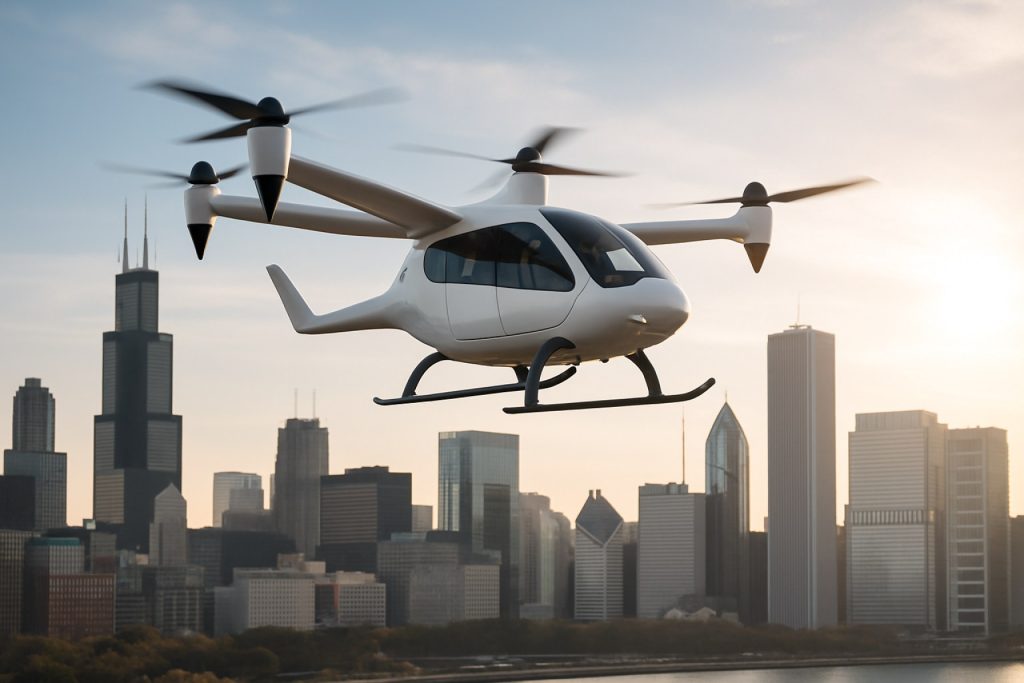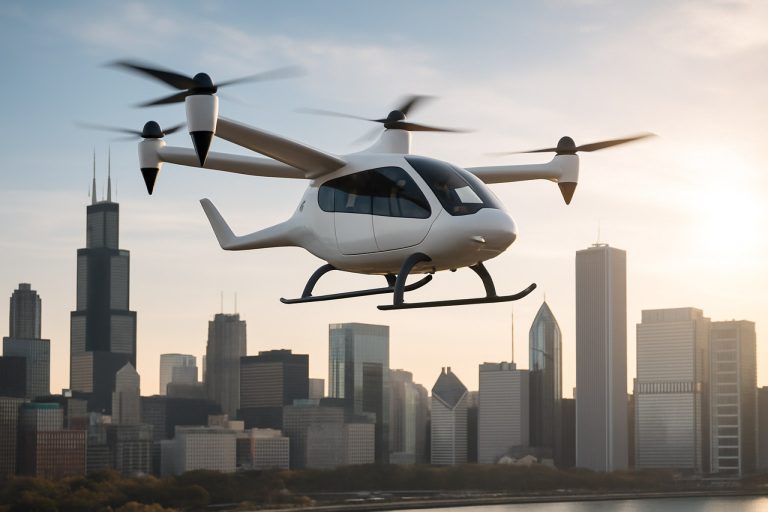
Autonomous Urban Air Mobility Industry Report 2025: Market Growth, Technology Innovations, and Strategic Forecasts. Explore Key Trends, Regional Leaders, and Opportunities Shaping the Next 5 Years.
- Executive Summary & Market Overview
- Key Technology Trends in Autonomous Urban Air Mobility
- Competitive Landscape and Leading Players
- Market Growth Forecasts (2025–2030): CAGR, Revenue, and Adoption Rates
- Regional Analysis: North America, Europe, Asia-Pacific, and Emerging Markets
- Future Outlook: Regulatory, Infrastructure, and Societal Impacts
- Challenges and Opportunities: Barriers to Adoption & Strategic Pathways
- Sources & References
Executive Summary & Market Overview
Autonomous Urban Air Mobility (UAM) refers to the deployment of highly automated, passenger- or cargo-carrying aerial vehicles within urban environments, aiming to alleviate ground congestion and revolutionize city transportation. By 2025, the global autonomous UAM market is poised for significant growth, driven by rapid advancements in electric vertical takeoff and landing (eVTOL) technology, artificial intelligence, and regulatory progress. The sector is attracting substantial investment from aerospace giants, technology firms, and urban planners seeking sustainable, scalable mobility solutions.
According to Morgan Stanley, the total addressable market for urban air mobility could reach $1 trillion by 2040, with autonomous operations expected to capture a growing share as regulatory frameworks mature. In 2025, the market is characterized by pilot projects, prototype testing, and early-stage commercial deployments in select cities, particularly in North America, Europe, and Asia-Pacific. Companies such as Joby Aviation, Lilium, and Volocopter are leading the charge, with several eVTOL aircraft undergoing certification and demonstration flights.
Key market drivers include urbanization, increasing demand for on-demand mobility, and the need to reduce urban traffic congestion and emissions. The integration of autonomous systems is expected to lower operational costs, enhance safety, and enable scalable deployment models. However, challenges remain, including airspace integration, public acceptance, infrastructure development, and evolving regulatory standards. The Federal Aviation Administration (FAA) and European Union Aviation Safety Agency (EASA) are actively developing certification pathways and operational guidelines for autonomous UAM vehicles.
In summary, 2025 marks a pivotal year for autonomous UAM, with the market transitioning from conceptualization to tangible implementation. Strategic partnerships between technology providers, city authorities, and regulators are accelerating progress, while ongoing investments signal strong confidence in the sector’s long-term potential. As pilot programs expand and regulatory clarity improves, autonomous UAM is set to become an integral component of future urban transportation ecosystems.
Key Technology Trends in Autonomous Urban Air Mobility
Autonomous Urban Air Mobility (UAM) is rapidly evolving, driven by technological advancements that are reshaping the future of urban transportation. In 2025, several key technology trends are defining the trajectory of this sector, with a focus on enhancing safety, efficiency, and scalability of autonomous aerial vehicles within complex urban environments.
- Advanced Sensing and Perception Systems: The integration of high-resolution LiDAR, radar, and multispectral cameras is enabling UAM vehicles to achieve superior situational awareness. These systems facilitate real-time obstacle detection, collision avoidance, and precise navigation in dense urban airspace. Companies like Honeywell are at the forefront, developing sensor suites specifically tailored for autonomous flight in cities.
- Artificial Intelligence and Machine Learning: AI-driven flight control algorithms are becoming increasingly sophisticated, allowing for dynamic route optimization, adaptive decision-making, and autonomous fleet management. These capabilities are essential for safe operations in unpredictable urban settings. Airbus and Volocopter are leveraging AI to enhance the autonomy and reliability of their UAM platforms.
- Vehicle-to-Everything (V2X) Communication: Seamless connectivity between UAM vehicles, ground infrastructure, and air traffic management systems is critical. V2X technologies are enabling real-time data exchange, cooperative traffic management, and integration with smart city networks. NASA is actively researching UAM traffic management frameworks that rely on robust V2X protocols.
- Battery and Propulsion Innovations: Advances in battery energy density and electric propulsion are extending flight ranges and reducing turnaround times. Solid-state batteries and hybrid-electric systems are being tested to meet the demanding requirements of urban operations. Joby Aviation and Lilium are leading efforts in this domain, with successful demonstrations of next-generation electric air taxis.
- Autonomous Ground Operations: Automation is extending beyond flight to include ground handling, charging, and maintenance. Smart vertiports equipped with autonomous docking and charging systems are being piloted to streamline UAM operations and minimize human intervention, as seen in projects by Siemens.
These technology trends are converging to accelerate the commercialization and scalability of autonomous UAM, positioning the sector for significant growth and urban integration in 2025 and beyond.
Competitive Landscape and Leading Players
The competitive landscape of the autonomous urban air mobility (UAM) market in 2025 is characterized by rapid innovation, strategic partnerships, and significant investments from both established aerospace giants and agile startups. The sector is witnessing a convergence of aviation, automotive, and technology companies, all vying to commercialize autonomous electric vertical takeoff and landing (eVTOL) aircraft for urban environments.
Leading players include Airbus, which continues to advance its CityAirbus NextGen program, focusing on fully electric, autonomous flight demonstrators. Boeing is leveraging its Boeing NeXt division to develop autonomous passenger air vehicles, emphasizing safety and regulatory compliance. Joby Aviation remains a frontrunner, having secured significant funding and partnerships, including a collaboration with Delta Air Lines to integrate UAM services into airport operations.
Startups such as Lilium and Volocopter are making notable progress, with Lilium’s jet-powered eVTOL and Volocopter’s multicopter design both undergoing advanced testing and pre-commercial deployments in select cities. EHang, based in China, is unique for its focus on fully autonomous, pilotless passenger drones, and has already conducted public demonstration flights in several countries.
Automotive and technology companies are also entering the fray. Hyundai Motor Group has established Supernal, its UAM division, with plans to launch commercial autonomous air taxi services by the end of the decade. Toyota has invested in SkyDrive, a Japanese startup developing compact, autonomous eVTOLs.
- Strategic alliances are common, with companies like Uber Elevate (now part of Joby Aviation) fostering ecosystem development through partnerships with manufacturers, infrastructure providers, and regulatory bodies.
- Regulatory progress, particularly in the U.S. and Europe, is shaping competitive dynamics, as companies that can demonstrate compliance with evolving safety standards gain a first-mover advantage.
- Investment activity remains robust, with venture capital and corporate investors fueling R&D and pilot projects worldwide, as reported by Morgan Stanley.
Overall, the 2025 autonomous UAM market is defined by a mix of established aerospace leaders, disruptive startups, and cross-industry collaborations, all racing to achieve commercial viability and regulatory approval in key urban centers.
Market Growth Forecasts (2025–2030): CAGR, Revenue, and Adoption Rates
The Autonomous Urban Air Mobility (UAM) market is poised for significant expansion between 2025 and 2030, driven by rapid advancements in autonomous flight technologies, increasing urban congestion, and supportive regulatory frameworks. According to projections by McKinsey & Company, the global UAM market—including autonomous passenger drones and air taxis—is expected to achieve a compound annual growth rate (CAGR) of approximately 30% during this period. This robust growth is underpinned by pilot projects in major metropolitan areas, rising investment from both public and private sectors, and the anticipated commercialization of autonomous eVTOL (electric vertical takeoff and landing) vehicles.
Revenue forecasts for the sector are equally optimistic. Morgan Stanley estimates that the global UAM market could generate revenues exceeding $20 billion by 2030, with autonomous operations accounting for a growing share as regulatory approvals accelerate. Early adoption is expected in regions with high urban density and progressive regulatory environments, such as North America, Western Europe, and parts of Asia-Pacific. For instance, EASA reports that over 30% of surveyed urban residents in Europe express willingness to use autonomous air taxis within the next five years, indicating a strong potential for rapid adoption once services become available.
- CAGR (2025–2030): Estimated at 28–32%, reflecting both technological maturation and regulatory progress.
- Revenue (2030): Projected to surpass $20 billion globally, with autonomous services representing a significant portion.
- Adoption Rates: Early pilot programs suggest initial adoption rates of 5–10% among urban commuters in select cities by 2030, with higher penetration in cities with established UAM infrastructure.
Key drivers for this growth include the scaling of autonomous flight systems, integration with smart city infrastructure, and the entry of major aerospace and technology firms such as Airbus and Boeing into the market. As regulatory clarity improves and public acceptance grows, the period from 2025 to 2030 is expected to mark the transition from demonstration projects to commercial-scale autonomous UAM operations.
Regional Analysis: North America, Europe, Asia-Pacific, and Emerging Markets
The regional landscape for Autonomous Urban Air Mobility (UAM) in 2025 is marked by distinct trajectories across North America, Europe, Asia-Pacific, and emerging markets, shaped by regulatory readiness, infrastructure investment, and public-private partnerships.
North America remains at the forefront, driven by robust R&D ecosystems and proactive regulatory frameworks. The United States, in particular, benefits from the Federal Aviation Administration’s (FAA) ongoing integration of UAM into the National Airspace System, with pilot programs in cities like Los Angeles and Dallas. Major players such as Joby Aviation and Aurora Flight Sciences are advancing commercial deployment, supported by significant venture capital and partnerships with urban planners. Canada is also making strides, focusing on intercity UAM corridors and leveraging its expertise in aerospace manufacturing (NASA).
Europe is characterized by a harmonized regulatory approach under the European Union Aviation Safety Agency (EASA), which has issued comprehensive guidelines for UAM vehicle certification and operations. Germany and France lead in pilot projects, with companies like Volocopter and Lilium conducting test flights and collaborating with city authorities for vertiport infrastructure. The European Commission’s UAM initiative aims to integrate air mobility into smart city frameworks, with a focus on sustainability and noise reduction (EASA).
- Asia-Pacific is emerging as a dynamic growth region, propelled by rapid urbanization and government-backed innovation. China’s Civil Aviation Administration is piloting UAM in megacities like Shenzhen, with EHang leading autonomous passenger drone deployments. Japan and South Korea are investing in UAM demonstration projects ahead of major events such as the Osaka Expo 2025, with support from conglomerates like Toyota and Hanwha Aerospace (McKinsey & Company).
- Emerging markets in Latin America, the Middle East, and Africa are exploring UAM as a solution to chronic urban congestion and limited ground infrastructure. While regulatory frameworks are nascent, cities like Dubai are piloting air taxi services with partners such as Volocopter, and Brazil is evaluating UAM for urban connectivity in São Paulo (International Civil Aviation Organization).
Overall, 2025 will see North America and Europe consolidating leadership in regulatory and commercial readiness, while Asia-Pacific accelerates adoption through public investment and emerging markets experiment with pilot deployments to address unique urban mobility challenges.
Future Outlook: Regulatory, Infrastructure, and Societal Impacts
The future outlook for autonomous urban air mobility (UAM) in 2025 is shaped by a dynamic interplay of regulatory evolution, infrastructure development, and societal acceptance. As the sector moves from pilot projects to early commercialization, these factors will be pivotal in determining the pace and scale of adoption.
On the regulatory front, 2025 is expected to see significant progress in the certification and operational frameworks for autonomous UAM vehicles. Aviation authorities such as the European Union Aviation Safety Agency (EASA) and the Federal Aviation Administration (FAA) are actively developing standards for airworthiness, pilot licensing (or operator oversight in the case of autonomy), and airspace integration. In 2025, regulatory sandboxes and special zones in cities like Paris, Los Angeles, and Singapore are anticipated to expand, allowing for real-world testing and limited commercial operations. However, full-scale deployment will remain contingent on the maturation of detect-and-avoid technologies and robust cybersecurity protocols.
Infrastructure is another critical enabler. By 2025, investment in vertiports—dedicated takeoff and landing hubs for UAM vehicles—will accelerate, with public-private partnerships driving the construction of initial networks in major metropolitan areas. Companies such as Urban-Air Port and Skyports are leading the way in designing modular, scalable vertiport solutions. Integration with existing urban transport systems, including seamless passenger transfers and digital ticketing, will be a focus, but challenges remain in grid connectivity, charging infrastructure for electric vertical takeoff and landing (eVTOL) vehicles, and urban zoning.
Societal impacts will become increasingly prominent in 2025. Public perception of safety, noise, and privacy will influence adoption rates. Early surveys by organizations like McKinsey & Company indicate cautious optimism, with higher acceptance in cities facing severe congestion. Community engagement, transparent communication about safety protocols, and demonstrable benefits—such as reduced travel times and lower emissions—will be essential to building trust. Additionally, workforce implications, including the need for new skills in UAM operations and maintenance, will begin to shape urban labor markets.
In summary, 2025 will be a formative year for autonomous UAM, with regulatory clarity, infrastructure readiness, and societal acceptance emerging as the primary determinants of progress toward mainstream adoption.
Challenges and Opportunities: Barriers to Adoption & Strategic Pathways
The adoption of Autonomous Urban Air Mobility (UAM) in 2025 faces a complex landscape of challenges and opportunities, shaping the sector’s trajectory and strategic priorities. Key barriers include regulatory uncertainty, technological maturity, public acceptance, and infrastructure readiness.
Barriers to Adoption
- Regulatory Hurdles: The absence of harmonized global standards for autonomous flight operations remains a significant impediment. While agencies like the Federal Aviation Administration and European Union Aviation Safety Agency are piloting frameworks for UAM, full-scale certification and integration into existing airspace are still evolving, causing delays in commercial deployment.
- Technological Limitations: Autonomous UAM systems require robust sense-and-avoid capabilities, reliable communications, and cybersecurity safeguards. As of 2025, these technologies are advancing but not yet universally proven in dense urban environments, according to NASA’s UAM research.
- Public Acceptance and Safety: Surveys by McKinsey & Company indicate that safety concerns and noise pollution are major factors influencing public willingness to adopt UAM. Incidents or perceived risks could slow adoption rates.
- Infrastructure Gaps: The lack of dedicated vertiports, charging stations, and air traffic management systems tailored for autonomous vehicles presents logistical challenges, as highlighted by EASA.
Strategic Pathways and Opportunities
- Regulatory Collaboration: Industry stakeholders are increasingly partnering with regulators to co-develop standards and certification pathways, as seen in initiatives by EASA and the FAA.
- Technology Pilots and Demonstrations: Companies such as Joby Aviation and Volocopter are conducting real-world pilot programs to validate autonomous systems and build public trust.
- Public Engagement: Transparent communication and community engagement initiatives are being prioritized to address safety and noise concerns, as recommended by NASA and EASA.
- Infrastructure Investment: Strategic partnerships between UAM operators, municipalities, and infrastructure providers are accelerating the development of vertiports and digital air traffic management, as reported by McKinsey & Company.
In summary, while significant barriers remain, targeted strategies and cross-sector collaboration are unlocking pathways for the scalable adoption of autonomous UAM in urban environments by 2025.
Sources & References
- Morgan Stanley
- Joby Aviation
- Volocopter
- European Union Aviation Safety Agency (EASA)
- Honeywell
- Airbus
- NASA
- Siemens
- Boeing
- Delta Air Lines
- EHang
- Hyundai Motor Group
- Toyota
- SkyDrive
- McKinsey & Company
- Aurora Flight Sciences
- International Civil Aviation Organization
- Skyports



